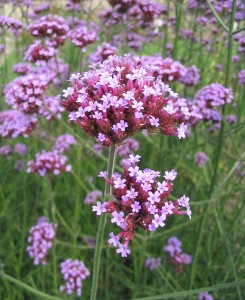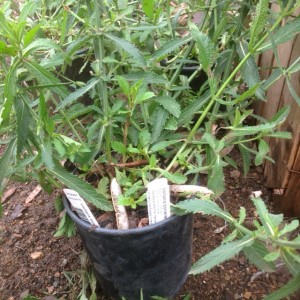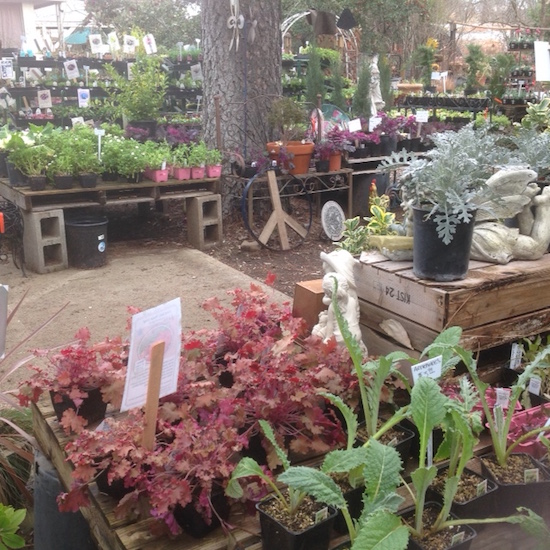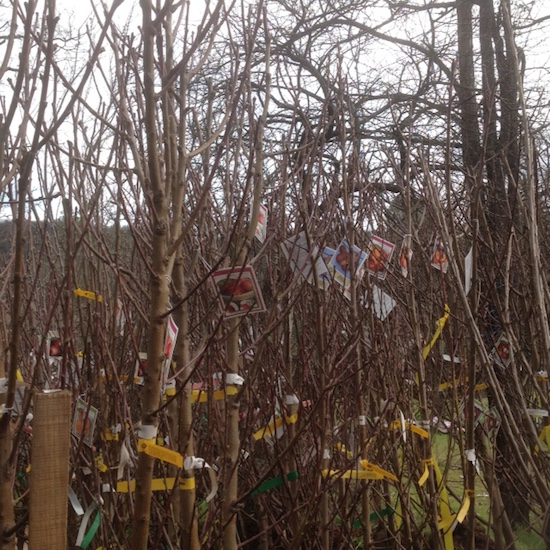 Plant of the Month
Plant of the Month
Verbena bonariensis
This verbena is very different from the usual verbena that comes to mind. It is very drought resistant once established and butterflies love it. Although Sunset only rates it to Zone 8, it does okay here and can self sow. It has naturalized in California. It grows up to 6 feet tall on airy, almost leafless stems with balls of purple flowers. Best if you get it in the ground early as it is hard to keep hydrated to get it established early. I think it looks best in mass or planted behind other perennials. Verbenas like well drained soil. Okay for a container but not as drought tolerant in that condition.
February Specials
- 20% OFF 6 packs Pansies and Violas
- 20% OFF Steer Manure 1 cf bags
- 20% OFF Plant of the Month- Verbena bonariensis
- 20% OFF Gopher Cages
2017 Overview
Please read our 2017 Star Gardens Overview on our website.
Our bare root orders: 2017 Fruit and Shade Trees | 2017 Roses
February Newsletter 2017
Already 4 of the 52 weeks are gone in 2017 and spring is right around the corner. There might be snow on the mountains as I write this but my daffodils are budding and the robins and a few cedar wax-wings are back and busy eating all the berries off the cotoneaster shrubs. More rain is expected so take advantage of the nice days to get some work done before it is too late. Please remember that even though are reservoirs and aquifers are filling we still live in a ‘Mediterranean’ climate and need to plan our gardens and yards with drought resistant, low water users in mind.
What work you ask? If you have not pruned your fruit trees, roses, and shaped young trees you had best get going. Do not feel bad because I have only done the nursery and have yet to prune my young fruit trees or my own roses. You can find great info on pruning fruit trees at davewilson.com, our fruit tree supplier. My perennial containers need work too as I have yet to cut back the phlox and caryopteris. My tomatoes were so huge this fall that I thought I would wait till they frosted to pull them so there would be less to deal with and they are still in the garden as well. Not too late to divide overly large clumps of perennials and grasses either. Its a good time to top dress your fruit trees and roses with steer manure. Do another copper spray on fruit trees between bud swell to 2/3 petal drop. This is to control fire blight on pears and apples and peach leaf curl on peaches and nectarines. Foraging insects can re-introduce these bacteria at this time even if you have already sprayed.
What to plant? Bare root season is upon us. The fruit and shade trees are here and roses will be arriving soon. The full lists of what we will have in February is on our website (fruit and shade trees / roses). You can still seed out wildflowers and if you have never grown sweet peas you owe it to yourself to plant some seed this month. Sweet peas are a spring annual here as our summers are way too hot for them. We have great mixes in our seed selections and will try to get some starts as well. Plant cool season vegetables, artichokes, asparagus, and strawberries. We have these in stock now along with seed. Feed your already established beds of asparagus and strawberries. Plant primrose, pansies and violas for early spring color. These will handle frost. Plant perennials as they become available. We are starting to get in fresh stock. Looking for early blooming shrubs? Some of the best are quince, lilacs, daphne, viburnums, and forsythia. We have them. One of my favorite winter blooming perennials are hellebores. These are an excellent choice for our climate. They are deer resistant and require little water, but do need summer shade.
So you are going to plant some trees and want some tips. Old timers say plant the graft scar facing north. If you are not sure what I mean by this ask us when you purchase your tree. Always plant so the crown (where the roots and trunk meet) is slightly above the existing soil grade so that water drains away from it. Make the hole only as deep as the roots as you do not want the soil settling your tree to deep in the ground but make it twice as wide. Add some GreenAll Firmulch and E B Stone Sure Start to the planting hole. Give serious consideration as to whether varmints are going to be an issue. Gophers love fruit trees, specially figs. Consider purchasing gopher cages or lining holes with gopher wire. Taller trees will need staking to help anchor them until they are fully rooted. They trunks need to be wrapped to protect from hot summer sun until there is enough canopy on the tree to shade itself.
Why all these latin names? All flora and fauna have them. From modern man to bacterias, a scientific latin name is given to it. Its a classification of genus and species.That is so it can be recognized world wide no matter what language you speak or common name you have for it. The latin name can often give you a hint as to the plant’s flower color, foliage color or shape, native habitat or growth habitat. Here are a few tips. Maybe we will start this as a feature of the news letter. One common species name following a genus is vulgaris or vulgare. This means common. Syringa vulgaris- Common lilac. Thymus vulgaris- Common thyme. Acaulis means stemless or short stemed like Primula acaulis- the short stemed varieties of primrose. Alba, album, albus means white, like Morus alba- the fruitless Mulberry tree whose roots are white. Aurea, aureus and aureum mean golden- Lysimachia nummularia Aurea- golden creeping jenny. Lutea means yellow. An example is Rosa banksia ‘Alba’ which is the white flowering one and Rosa banksia ‘Lutea’ the yellow flowering one. Repens or reptans means creeping so you know it is a low growing plant like Ajuga repens. Subulata means prostrate like Phlox subulata, commonly called creeping phlox, the low growing spring bloomer. The taller growing summer bloomer is Phlox paniculata. Paniculata means the flowers are arranged in a panicle-a loose cluster.
Back in the day before Winter, Spring, Summer and Fall people in the Old World marked the seasons differently. They had names but I do not have the article in front of me and I could not find anything after a quick web search. I thought the term Mid Seasons had been given to them. They coincided more with the natural order of things. The winter solstice was in the middle of ‘winter’ and the summer solstice fell in the middle of ‘summer’. You basically had your season of lambing, calving and soil prep and planting from mid Feb-April (Spring), growing season (May-July), harvest season (August- October) and your rest or fallow season (Nov- Jan). Makes a lot more sense to me. So you see, planting time is nigh.




